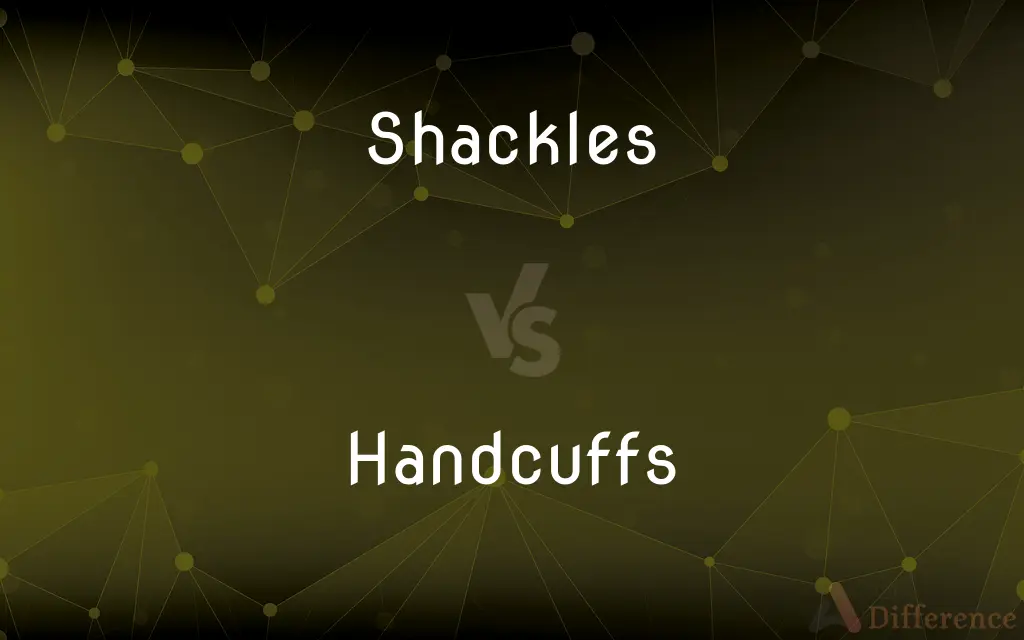Shackles vs. Handcuffs — What's the Difference?
Edited by Tayyaba Rehman — By Maham Liaqat — Updated on March 15, 2024
Shackles are devices used for securing a person's ankles, often heavy and used for severe restraint, while handcuffs are designed for the wrists, lighter, and more commonly used in law enforcement for temporary restraint.

Difference Between Shackles and Handcuffs
Table of Contents
ADVERTISEMENT
Key Differences
Shackles are typically designed for the ankles, made from heavy metal, and are used in situations requiring stringent control, such as in prisons or during long-term detainment. They are often seen as symbols of severe restraint and can be used in combination with chains to limit movement significantly. On the other hand, handcuffs are primarily designed for the wrists, crafted from lighter materials, and are widely utilized by law enforcement for temporary and safe restraint of individuals. Handcuffs allow for some degree of movement and are considered less severe than shackles.
The use of shackles is often associated with historical practices of restraint and punishment, evoking images of long-term imprisonment and the transportation of convicts. Conversely, handcuffs are closely tied to modern policing and criminal apprehension, symbolizing temporary custody and the intent to uphold public safety without causing undue harm.
Shackles, due to their weight and design, can significantly impede an individual's ability to walk or move, making them suitable for situations where high security is paramount. Handcuffs, while also restrictive, allow detainees more freedom of movement, enabling law enforcement officers to manage suspects more effectively during transport or processing.
The choice between shackles and handcuffs depends on the level of restraint needed and the context of use. Shackles are less common in everyday law enforcement and are reserved for specific scenarios requiring heightened security. In contrast, handcuffs are a standard tool for officers, balancing the need for restraint with considerations for human rights and dignity.
Despite their different applications, both shackles and handcuffs serve the purpose of restraint. However, their use is subject to legal and ethical considerations, reflecting society's values concerning freedom, security, and the treatment of individuals under restraint.
ADVERTISEMENT
Comparison Chart
Primary Use
Securing ankles, often for long-term restraint.
Temporarily restraining wrists in law enforcement.
Material Weight
Heavy, made from robust metals.
Lighter, designed for ease of use and transport.
Movement Restriction
Significantly limits mobility, especially walking.
Allows some hand and arm movement.
Historical Connotation
Associated with severe punishment and long-term imprisonment.
Tied to modern policing and temporary custody.
Application Context
High-security environments, long-term detainment.
Daily law enforcement, temporary restraint.
Compare with Definitions
Shackles
Heavy restraints for ankles, used for stringent control.
The prisoner was put in shackles to prevent escape attempts.
Handcuffs
Restraints for wrists, used by law enforcement for temporary control.
The officer used handcuffs to detain the suspect safely.
Shackles
Symbolic of severe punishment and restriction.
Shackles are often used in historical accounts of imprisonment.
Handcuffs
Lighter and more practical for everyday use.
Handcuffs are designed for quick application and removal.
Shackles
Designed to impede walking and movement significantly.
Walking in shackles requires great effort due to their weight.
Handcuffs
Symbolic of law enforcement and temporary custody.
Handcuffs are a recognized tool in the police force's arsenal.
Shackles
Used in scenarios requiring heightened security.
High-risk detainees are often transported in shackles.
Handcuffs
Balance restraint with considerations for dignity.
Handcuffs are used to maintain control without undue harm.
Shackles
Reflect a historical method of long-term detainment.
Shackles were commonly used in transporting convicts in the past.
Handcuffs
Allow for limited hand and arm movement.
Despite being handcuffed, the suspect could still move his arms slightly.
Shackles
A device, usually one of a pair connected to a chain, that encircles the ankle or wrist of a prisoner or captive.
Handcuffs
Handcuffs are restraint devices designed to secure an individual's wrists in proximity to each other. They comprise two parts, linked together by a chain, a hinge, or rigid bar.
Shackles
A hobble for an animal.
Handcuffs
A restraining device consisting of a pair of strong, connected hoops that can be tightened and locked about the wrists and used on one or both arms of a prisoner in custody.
Shackles
Any of several devices, such as a clevis, used to fasten or couple.
Handcuffs
To put handcuffs on (a person).
Shackles
Often shackles A restraint or check on action or progress
"throwing off the puritanical shackles" (Ben Yagoda).
Handcuffs
To restrain or render ineffective.
Shackles
To put shackles on (someone); confine with shackles.
Handcuffs
A fastening consisting of two metal rings, designed to go around a person's wrists, and connected by a chain or hinge.
Shackles
To fasten or connect with a shackle.
Handcuffs
Shackle that consists of a metal loop that can be locked around the wrist; usually used in pairs
Shackles
To restrict, confine, or hamper.
Shackles
Plural of shackle
Common Curiosities
How do handcuffs differ from shackles in terms of mobility?
Handcuffs allow for some degree of hand and arm movement, whereas shackles significantly limit an individual's ability to walk or move freely.
What are shackles used for?
Shackles are used for securing a person's ankles, typically in high-security environments or situations requiring long-term restraint.
Are shackles considered more inhumane than handcuffs?
Shackles are often viewed as more severe due to their weight, design, and the greater restriction they impose, making them less suitable for situations where lesser restraint is adequate.
Can handcuffs be used on the ankles?
While handcuffs are designed for the wrists, in certain situations, they may be used on ankles, but this is less common and not their intended purpose.
Do handcuffs come in different sizes and designs?
Yes, handcuffs are available in various sizes and designs to accommodate different wrist sizes and operational requirements, including chain-linked and hinged models.
In what scenarios are shackles preferred over handcuffs?
Shackles are preferred in situations that demand heightened security and severe restriction of movement, such as transporting high-risk detainees.
Are there alternatives to handcuffs and shackles for restraining individuals?
Alternatives include restraint belts, zip ties, and other devices designed to limit movement without the use of traditional metal restraints, each with its own set of advantages and limitations.
What legal and ethical considerations surround the use of handcuffs and shackles?
The use of handcuffs and shackles is subject to legal and ethical considerations, including the necessity and proportionality of restraint, respect for human dignity, and the potential for physical and psychological harm.
What role do shackles play in historical accounts of imprisonment?
Shackles are frequently mentioned in historical narratives of imprisonment and punishment, symbolizing the severe restriction of freedom and harsh conditions faced by detainees.
How has the use of shackles evolved over time?
Historically, shackles were widely used for long-term imprisonment and the transport of convicts. Their use has evolved with changing attitudes towards punishment and human rights, becoming less common in everyday law enforcement.
Share Your Discovery

Previous Comparison
Bung vs. Bungstarter
Next Comparison
Globe vs. MapAuthor Spotlight
Written by
Maham LiaqatEdited by
Tayyaba RehmanTayyaba Rehman is a distinguished writer, currently serving as a primary contributor to askdifference.com. As a researcher in semantics and etymology, Tayyaba's passion for the complexity of languages and their distinctions has found a perfect home on the platform. Tayyaba delves into the intricacies of language, distinguishing between commonly confused words and phrases, thereby providing clarity for readers worldwide.
















































